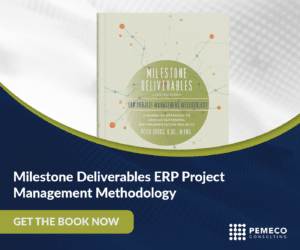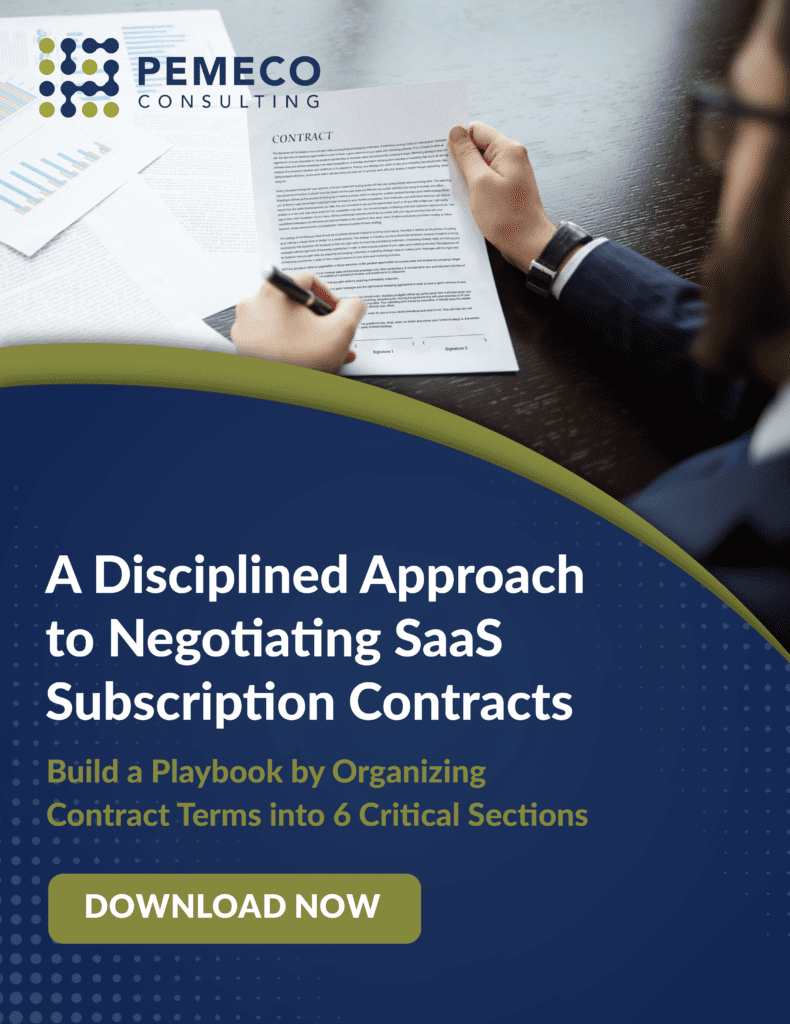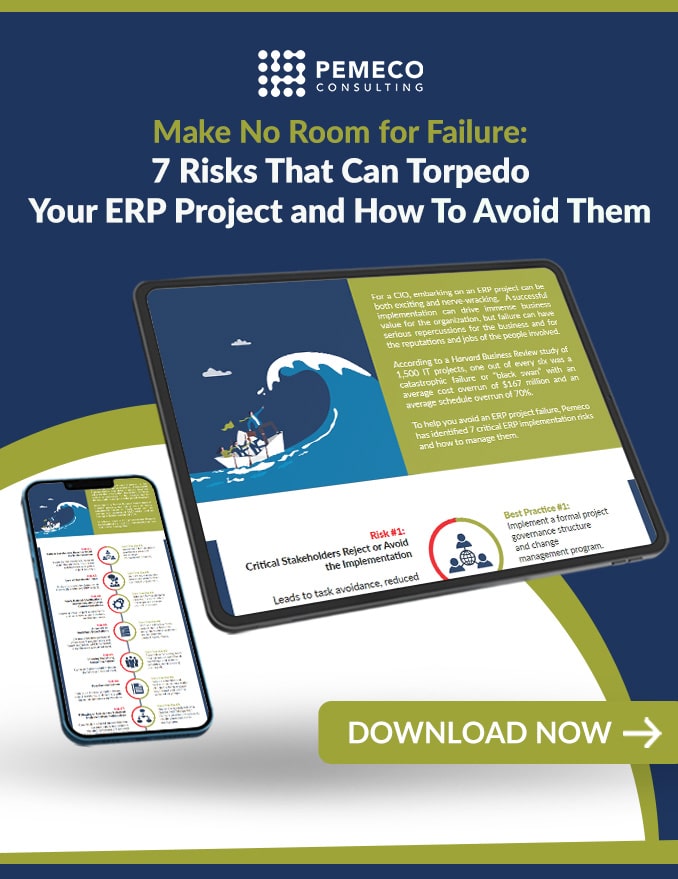Companies that run top-performing projects share a common trait: they rigorously measure and monitor project performance. According to research from the Project Management Institute (PMI)’s Project Success Initiative, organizations that define project success criteria upfront, implement strategic key performance indicators (KPI), and monitor project performance achieve significantly higher project success rates.
The same holds true for ERP projects. Reflecting on our firm’s experience dating back to the 1970s, we’ve observed that ERP projects run much more smoothly when the right business, project, and change management measures are integrated. Let’s dive into our proven framework.
A Measurement-Based Framework for ERP Projects
A strong measurement-based framework provides teams with the tools to track performance, make necessary course corrections, and effectively manage risk. Project leaders who use KPIs well do so in three ways: they define metrics early, they vary the metrics based on the project demands, and they empower people to act.
Here’s how you can do the same:
Define your KPIs Early
You should aim to define project KPIs no later than the completion of the project charter. Often, you might even want to do so sooner, well before you kick off your ERP implementation. Many of our clients have foundational projects that precede and are critical to implementation. For example, many need to backfill key project personnel, clean up data, and even change certain business processes. By implementing and refining your KPI management system before implementation, you can test and refine the process while the stakes are lower than during an ERP implementation.
Adjust your KPIs to Meet Project Demands
It’s important that you don’t rigidly adhere to a common set of KPIs throughout the entire project. Because different stages of the project create different demands, you will want to vary your KPIs to meet the needs of the day. For example, your early-stage KPIs might focus on project governance processes, planning milestones, core team training effectiveness, and organizational alignment. Meanwhile, during later phases, you might establish KPIs to track testing, data migration, and end-user training effectiveness.
Empower People and Drive Accountability
In our experience, projects go south when leadership expects just one person or group to be fully responsible and accountable for ERP project delivery. Projects that perform best are those that spread clearly defined responsibilities and accountabilities across the organization. Each team, from the C-suite to the front lines, should be accountable for their own metrics. For example, your steering committee might measure approved change orders, approved deviations from standard best practices, and deviations from approved personnel commitments. In contrast, a core team member might be measured against their documented business scenarios, completed tests, and completed training guides.
Identifying the Right KPIs
With an understanding of the base framework, the next question is, what should you measure?
Tracking too many metrics – or the wrong metrics – is counterproductive. You could end up diverting resources to something that doesn’t move the needle on a major issue. Instead, you want to be disciplined about your measures – to laser-focus your KPIs on indicators that track whether your project is on track and what adjustments need to be made. For our clients, we group KPIs into three broad categories: project management, organizational change management, and business improvement.
Project Management KPIs
Project Management KPIs keep you on top of the ‘iron triangle’ — schedule, budget, and scope. Here are a few categories of metrics:
- Schedule Adherence: Are tasks being completed on time relative to the project plan?
- Budget Tracking: Are costs in line with projections at each phase?
- Scope Control: Is the project staying within its defined boundaries, or are there signs of scope creep?
- Milestone Achievement: Are key deliverables being met at each stage of the project lifecycle?
- Resource Utilization: How effectively are resources being used throughout the project?
KPIs in Practice: Businesses usually underestimate the amount of work that is required to support data migration activities and, accordingly, understaff the workstream. As with many of our clients, this particular client had fallen behind. Project management sounded an alarm by showing the Steering Committee statistics on the volumes of data that had to be transformed and mapped, the time required to complete the activities, and the available capacity to do the work. The PM left the Steering Committee with two choices: apply more resources or delay the upcoming system integration testing phase. The Steering Committee decided to expand the consulting budget to avoid schedule slippage.
Organizational Change Management KPIs
Organizational Change Management (OCM) KPIs track how effectively an implementing company manages the people side of change. During ERP implementation, our clients use OCM metrics to enable organizational alignment, to breakdown project resistance, and to assure readiness to perform project activities. After cutover, our clients use OCM metrics to ensure that people are adopting the new processes and using the systems as designed. The categories of OCM metrics include:
- Change Readiness, Communications, & Engagement: How well do the stakeholder groups understand the project objectives, scope, demands, and impacts?
- Training Effectiveness: How well has the core team been trained to support their implementation duties? How well have end-users been trained to adopt the new processes?
- User Adoption: Are the end-users adopting the new processes and systems as designed? What is their level of proficiency?
KPIs in Practice: Two months after cutover, our client was cancelling and deleting more than 20% of confirmed sales orders. This KPI showed that our client’s customer service department was struggling to adopt the new order management processes. We learned that because of understaffing and the high volume of orders, the customer service team did not have time to properly consume the training materials. So, we deployed a multi-pronged strategy to improve adoption. First, we deployed super users to sit with customer service personnel to immediately improve operational performance and provide on-the-job training. Second, we delivered an online guided learning solution that sat on top of the live application, allowing the team to train while performing their job duties.
Business Improvement KPIs
Our clients use this category of KPIs to drive the realization of the business benefits of the new processes and systems – oftentimes related to process efficiency. To help our clients define metrics that focus on maximal business value, we cascade the KPIs from strategic targets down to the operational level. In our Milestone Deliverables ERP Implementation Management Methodology, we discuss two types of KPIs (you can read more about them here):
- Strategic Business Accomplishments (SBAs): Strategy-level KPIs that define executive-level metrics and targets
- Measurable Success Factors (MSFs): Operational and business process level KPIs
KPIs in Practice: Our high-volume distribution client had a strategic objective to improve its top-line revenues by 10%. We broke that SBA down into multiple threads, one of which drove an MSF to improve quotation win rates by 6% and drive an incremental $500,000 in revenue. We learned that orders dropped off because customers would find alternate suppliers while our client’s Customer Service team chased down key order information. used this MSF to design processes that provided customer service with immediate pricing and inventory availability so that they could confirm orders within 20 minutes of a quotation request.
You Can’t Manage What You Don’t Measure
The prospects that your ERP project succeeds – and that your business realizes major business value – drastically increase if you measure the right outcomes. By embedding the right KPIs into every phase of the project, you ensure that your teams can make data-driven decisions, keep your project on track, and deliver meaningful business value.
If you need help maximizing the value of your ERP investment, contact Pemeco. With over 40 years of experience in ERP consultancy and a 100% ERP implementation success rate, we can help you build a strategy aligned with your unique business objectives and successfully deliver your ERP implementation project.






